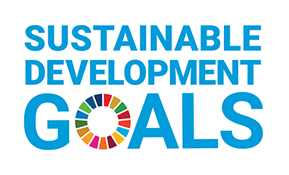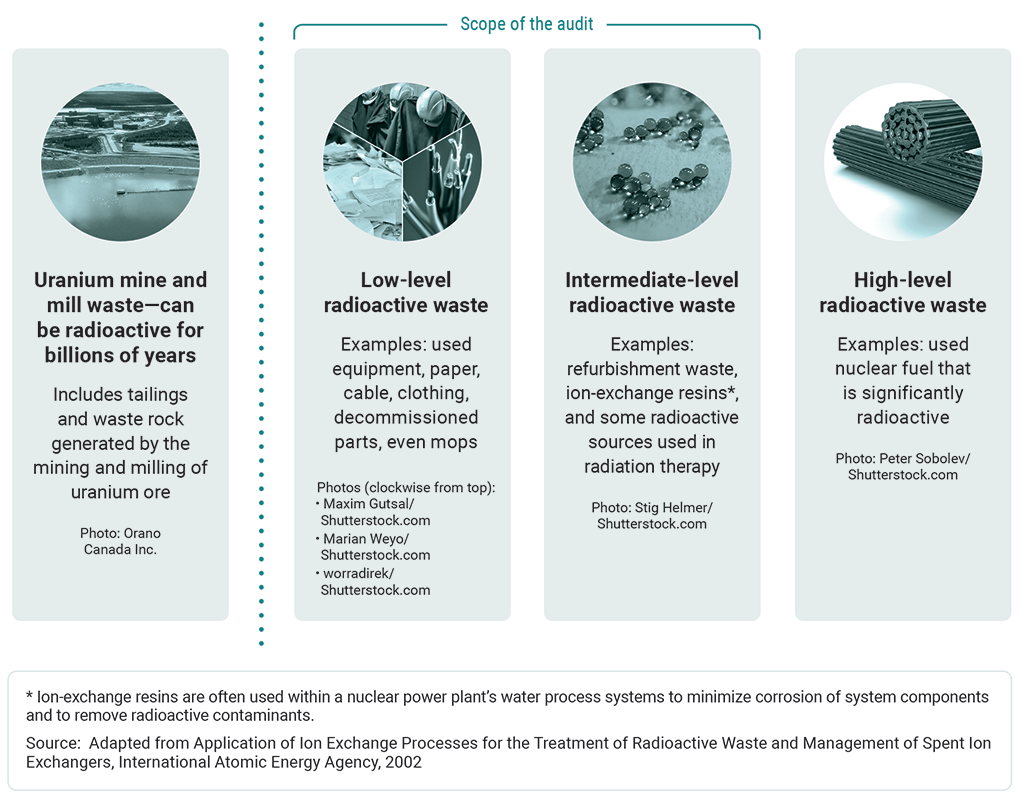2022 Reports 6 to 10 of the Commissioner of the Environment and Sustainable Development to the Parliament of Canada
Report 6—Management of Low and Intermediate Level Radioactive Waste
At a Glance
Overall, we found that Natural Resources Canada, the Canadian Nuclear Safety Commission, and Atomic Energy of Canada Limited did a good job of managing the low and intermediate level radioactive waste that makes up 99.5% of Canada’s radioactive waste output. The entities’ management of this waste aligns with key international standards that seek to protect the environment and the safety of current and future generations. Canada’s previous and ongoing use of nuclear technology has created a legacy of radioactive waste that will be with us for years to come.
Why we did this audit
- Low and intermediate level waste represents the majority of the volume of radioactive waste in Canada. Understanding how Canada manages radioactive waste is important to minimize the burden of that waste on future generations.
- Inaccurate information about radioactive waste inventory can affect related decisions, such as how to prepare the waste for eventual disposal.
- Regulatory oversight of radioactive waste management facilities ensures accountability and ultimately keeps Canadians safe.
Our findings
- Atomic Energy of Canada Limited was improving its inventory information, but public reporting could be enhanced.
- The Canadian Nuclear Safety Commission used risk based planning but documentation could be strengthened.
- Natural Resources Canada was modernizing the national radioactive waste management policy.
Key facts and figures
- Most of the historic waste in Canada is contaminated soil. Historic waste makes up 82% of all low level radioactive waste in Canada and dates as far back as the 1930s. Legacy waste is estimated to make up 14% of Atomic Energy of Canada’s total volume of radioactive waste.
- We identified 278 low and intermediate level radioactive waste compliance cases and we found that 30 of the 278 cases were not captured in the tracking system.
- Every year, a portion of the planned liability work is carried out. In the 2020–21 fiscal year, this work represented close to $600 million in costs for decommissioning, remediation, and storage of radioactive waste.
Highlights of our recommendations
- Atomic Energy of Canada Limited should ensure that its public reporting clearly aligns its plans and activities with how it is addressing historic and legacy waste. For increased transparency, these reports should include monitoring activities and timelines.
- The Canadian Nuclear Safety Commission should fully and consistently document the rationale used throughout its planning of compliance verification activities for licensed low- and intermediate‑level radioactive waste management facilities.
Please see the full report to read our complete findings, analysis, recommendations and the audited organizations’ responses.


Natural Resources Canada stated that it did not directly consider the United Nations’ Sustainable Development Goal 12 (responsible consumption and production) and had not created specific indicators in support of this goal as part of its policy modernization. The management of radioactive waste is directly linked to target 12.4, which refers to the environmentally sound management of all wastes throughout their lifecycle and the minimization of adverse impacts on human health and the environment. In our view, Natural Resources Canada should place greater emphasis on its consideration of Goal 12 as part of the development and future implementation of its modernized policy.
Visit our Sustainable Development page to learn more about sustainable development and the Office of the Auditor General of CanadaOAG.
Exhibit Highlights
Canada’s 4 classes of radioactive waste

Source: Based on information from the Canadian Nuclear Safety Commission
Text version
This chart shows Canada’s 4 classes of radioactive waste—uranium mine and mill waste, low-level radioactive waste, intermediate-level radioactive waste, and high-level radioactive waste. It also indicates the 2 classes that are within the scope of the audit—low-level radioactive waste and intermediate-level radioactive waste. Each class of radioactive waste includes photos of examples.
| Uranium mine and mill waste (not in the scope of the audit) |
Low-level radioactive waste (within the scope of the audit) |
Intermediate-level radioactive waste (within the scope of the audit) |
High-level radioactive waste (not in the scope of the audit) |
|---|---|---|---|
|
Uranium mine and mill waste can be radioactive for billions of years. It includes tailings and waste rock generated by the mining and milling of uranium ore. |
Low-level radioactive waste includes used equipment, paper, cable, clothing, decommissioned parts, and even mops. |
Intermediate-level radioactive waste includes refurbishment waste, ion-exchange resinsFootnote *, and some radioactive sources used in radiation therapy. |
High-level radioactive waste used nuclear fuel that is significantly radioactive. A photo shows used fuel rods. |
Photo credits:
A mining facility that includes a tailings pond: Orano Canada Inc.
Used helmets and uniforms: Maxim Gutsal/Shutterstock.com
Used cable: Marian Weyo/Shutterstock.com
Used paper: worradirek/Shutterstock.com
Resin beads: Stig Helmer/Shutterstock.com
Used fuel rods: Peter Sobolev/Shutterstock.com
Infographic

Text version
Although radioactive waste disposal was not covered in our audit, Management of Low and Intermediate Level Radioactive Waste, a proposal for Canada’s first waste disposal facility has been made, and the decision process is ongoing.
There are 3 levels of radioactive waste: low, intermediate, and high.
- Low‑level waste will be radioactive for up to 300 years and makes up 98.9% of Canada’s radioactive waste. Contaminated soil is one example of it. The proposed waste disposal facility will address some low‑level radioactive waste.
- Intermediate-level waste will be radioactive for more than 300 years and makes up 0.6% of Canada’s radioactive waste. Ion‑exchange resins are one example of it.
- High‑level waste will be radioactive indefinitely and makes up 0.5% of Canada’s radioactive waste. Used nuclear fuel rods are one example of it.
In addition, uranium mine and mill waste, which includes tailings and waste rock generated by mining and milling uranium ore can be radioactive for billions of years.
Some examples of low‑level radioactive waste disposal facilities include trenches, above-ground mounds, and rock caverns. Many countries around the world have disposal facilities designed to meet their own specific needs. The above-ground mound is similar to the near‑surface disposal facility being considered for Canada. These mounds are built on the surface of the ground and mounded over with a cap and cover system. They are used to dispose of radioactive waste that takes from 100 to 300 years to decay.
The proposed near‑surface disposal facility will dispose of items such as contaminated soil, protective clothing, equipment, decommissioned parts, components used for research and for medicine, and waste currently being stored elsewhere. The facility would be located in Deep River, Ontario, and would be 16 hectares or 0.16 square kilometres in size. Its current timeline is as follows:
- 2021—Canadian Nuclear Laboratories completes Environmental Impact Statement
- 2022 to 2023—public hearings
- 2023—decision expected
- 2023 to 2025—construction (if approved)
- ongoing after 2026—dispose of and monitor radioactive waste
Understanding how Canada manages radioactive waste and who manages it is important to minimize the burden of that waste on future generations. To learn more, read our report, Management of Low and Intermediate Level Radioactive Waste.
Related information
Entities
Tabling date
- 4 October 2022
Related audits
- 2016 Fall Reports of the Commissioner of the Environment and Sustainable Development
Report 1—Inspection of Nuclear Power Plants—Canadian Nuclear Safety Commission
